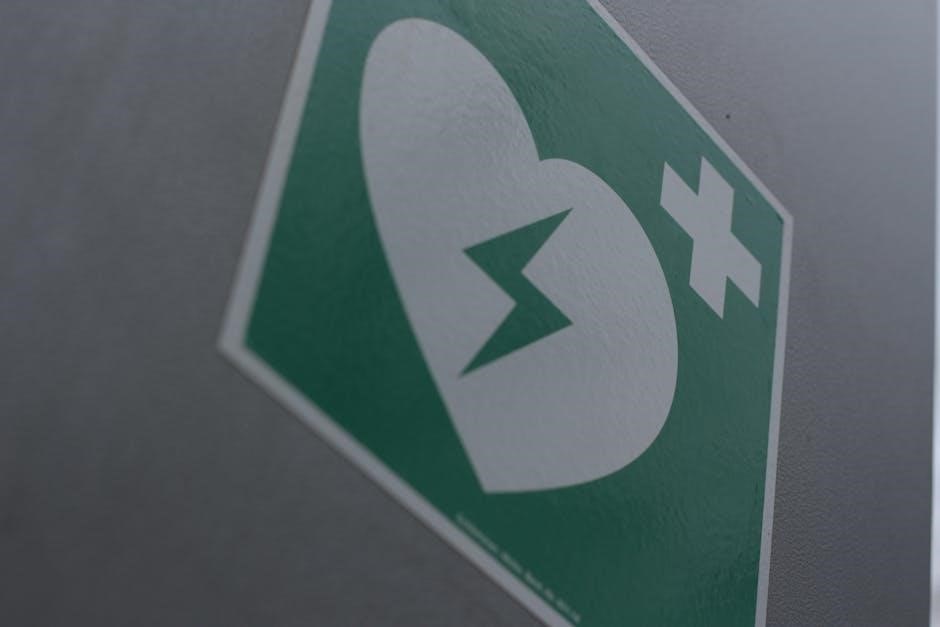first aid step 3 pdf
Overview of First Aid Steps
First aid is a structured process designed to provide immediate care for injuries or illnesses. It typically follows a sequence of steps to ensure effective and safe assistance. The first step usually involves assessing the scene for safety and checking the casualty’s condition. This is followed by providing basic care, such as controlling bleeding or supporting breathing. The third step often focuses on ongoing assessment and stabilization until professional help arrives. Understanding these steps is crucial for anyone trained in first aid, as they guide the responder in prioritizing actions and ensuring the best possible outcomes. Proper training helps individuals master these steps, enabling them to act confidently and effectively in emergencies.
Importance of Step 3 in First Aid
The third step in first aid is crucial as it ensures the safety of both the first aider and the casualty. Assessing the scene and the casualty’s condition allows for immediate identification of potential risks and the need for urgent care. By checking for breathing, responsiveness, and controlling bleeding, this step prevents further harm and stabilizes the situation. It also enables the first aider to provide reassurance, which can calm the casualty and improve their response to treatment. Additionally, Step 3 ensures that critical conditions, such as cardiac arrest or severe injuries, are addressed promptly. Without this step, vital signs might be overlooked, leading to delayed recovery or complications. Thus, Step 3 is essential for effective and timely first aid intervention.

Understanding the “Check” Step in First Aid
The “Check” step involves assessing the scene and casualty to ensure safety, evaluate conditions, and determine the need for immediate action or further assistance.
Assessing the Scene for Safety
Assessing the scene for safety is the first critical step in first aid. Before approaching the casualty, ensure the environment is safe for both you and the person in need. Check for potential hazards such as spills, broken glass, or unstable structures. If the situation involves vehicles, make sure they are turned off and the area is clear of traffic. Always prioritize your own safety, as you cannot help others if you become injured. If necessary, wear personal protective equipment (PPE) like gloves or a mask. Once the scene is deemed safe, take control of the situation calmly and efficiently. This step ensures that first aid can be provided without risking further harm to anyone involved. Remember, safety always comes first in any emergency situation.
Evaluating the Casualty’s Condition
Evaluating the casualty’s condition involves assessing their responsiveness, airway, breathing, and circulation (ABCs). Start by checking if the person is responsive through verbal or physical means. If unresponsive, proceed to assess their airway by tilting their head and lifting their chin to ensure it is clear. Listen for breathing sounds and feel for breath on your cheek. If the casualty is not breathing or only gasping, begin CPR immediately. For injuries, control bleeding by applying direct pressure with a clean cloth or bandage. Monitor for signs of shock, such as pale skin or rapid heartbeat. If the casualty is conscious, ask about their symptoms to identify potential issues like head injuries or fractures. Always summon professional help if the situation is severe or beyond your training. Proper evaluation ensures timely and effective care.

Identifying the Need for Immediate Action
Identifying the need for immediate action in first aid step 3 is crucial for preventing further harm and ensuring timely care. This step involves quickly assessing the casualty’s condition to determine if urgent intervention is required. Key factors include checking for breathing, responsiveness, and severe injuries like uncontrolled bleeding or chest pain. If the casualty is unresponsive or not breathing, immediate action such as CPR or calling for emergency services is necessary. Additionally, environmental hazards or worsening symptoms may demand swift response. First aiders must prioritize life-threatening conditions, such as cardiac arrest or choking, and act decisively to stabilize the situation. Recognizing these critical signs ensures appropriate care is provided without delay, significantly improving outcomes. Proper training enables first responders to make quick, informed decisions in high-stress scenarios. Always remember, timely action can be the difference between recovery and severe complications;

Key Actions in First Aid Step 3
Key actions in First Aid Step 3 involve checking for breathing and responsiveness, assessing the ABCs (Airway, Breathing, Circulation), and controlling bleeding or stabilizing injuries to prevent further harm.
Checking for Breathing and Responsiveness
Checking for breathing and responsiveness is a critical step in first aid. Begin by gently tapping the casualty on the shoulder and asking, “Are you okay?” to assess their responsiveness. If they respond, they are conscious. If not, check for breathing by looking for chest movements, listening for breath sounds, and feeling for air on your cheek. If the person is unresponsive and not breathing, immediately proceed to CPR. This step ensures you determine the severity of the situation and whether immediate interventions, like calling emergency services, are necessary. Proper assessment guides the next actions, ensuring timely and effective care. Always follow first aid training guidelines to perform this step accurately and safely.
Assessing the Airway, Breathing, and Circulation (ABCs)
Assessing the ABCs is a critical step in first aid, ensuring the casualty’s airway, breathing, and circulation are stable. Start by checking the airway for obstructions, tilting the head and lifting the chin if necessary. Next, listen for breath sounds and feel for air on your cheek to confirm breathing. If the person is unresponsive and not breathing, call for emergency help immediately. For circulation, check for signs of bleeding or shock, such as pale skin or rapid heartbeat. If no pulse is detected, begin CPR. Properly assessing the ABCs ensures the casualty receives immediate, life-saving interventions, preventing further deterioration and promoting recovery. This step requires attention to detail and adherence to first aid protocols to maximize effectiveness.
Controlling Bleeding and Stabilizing Injuries
Controlling bleeding and stabilizing injuries are critical actions in first aid step 3. Apply direct pressure using a clean cloth or dressing to stop bleeding, elevating the injured limb above heart level if possible. Use tourniquets only in severe cases where other methods fail. For injuries like fractures, immobilize the affected area with splints or rigid supports to prevent further damage. Avoid moving the casualty unnecessarily and monitor for signs of shock, such as pale skin or rapid breathing. If an object is embedded in the wound, do not remove it; stabilize the area and seek professional help immediately. Proper wound management and stabilization are essential to prevent complications and promote recovery. These steps ensure the casualty remains stable until advanced medical care is available.

Communication in First Aid Step 3
Effective communication in first aid step 3 involves asking questions to assess the situation, providing reassurance to the casualty, and summoning help when necessary to ensure proper care;
Asking Questions to Understand the Situation
Effective communication is crucial in first aid. Asking the right questions helps first responders gather essential information about the casualty’s condition and the incident. Key questions include the cause of the injury, how long symptoms have been present, and if the person has any medical conditions or allergies. This step ensures that care is tailored to the individual’s needs, reducing risks and improving outcomes. Open and clear dialogue also reassures the casualty, fostering trust and cooperation. By understanding the situation thoroughly, first aiders can prioritize actions and make informed decisions, ensuring safety and effectiveness in their response.
Providing Reassurance to the Casualty
Providing reassurance to the casualty is a crucial aspect of first aid step 3, helping to calm their nerves and prevent panic. Speak clearly and gently, ensuring they understand you are there to help. Avoid making promises you cannot keep, but instead, focus on positive affirmations to instill confidence. If the casualty is conscious, explain the actions you are taking to address their condition. This communication helps reduce anxiety and fosters trust between you and the casualty. Maintaining a composed demeanor and empathetic tone can significantly impact their emotional state. Reassurance also extends to physical comfort, such as adjusting their position or covering them with a blanket if needed. By providing emotional support, you create a more stable environment for effective care.
Summoning Help When Necessary
Summoning help is crucial when the situation exceeds your ability to provide adequate care. Always call emergency services if the casualty’s condition is severe or life-threatening. Provide clear, concise information about the location and nature of the emergency. If possible, send someone to fetch help or guide responders to the scene. Stay with the casualty until professional assistance arrives, ensuring their safety and comfort. Prompt action can significantly improve outcomes, emphasizing the importance of swift communication and collaboration.
Special Considerations in First Aid Step 3
In first aid step 3, special attention is given to handling diverse injuries, managing multiple casualties, and addressing legal and ethical responsibilities to ensure compassionate and effective care.
Handling Different Types of Injuries or Conditions
Handling different types of injuries or conditions requires a tailored approach during the “Check” step in first aid. For general injuries, such as cuts or sprains, the focus is on controlling bleeding and stabilizing the affected area. In cases of burns, cooling the skin and covering it appropriately is essential. For fractures, immobilization is key to prevent further damage. When dealing with conditions like poisoning or allergic reactions, identifying the cause and providing specific care, such as administering an antidote or epinephrine, is critical. Communicating with the casualty to understand their symptoms and medical history helps in providing accurate care. Additionally, reassessing the situation regularly ensures that interventions are adjusted as needed. Proper training and knowledge of these variations are vital for effective first aid response.
Working with Multiple Casualties
When dealing with multiple casualties, it is crucial to remain calm and systematic. Assess each individual quickly, prioritizing those with life-threatening injuries. Use the “Check” step for each casualty to evaluate their condition, focusing on airway, breathing, and circulation. Triage patients based on the severity of their injuries, ensuring those in critical need receive immediate attention. Communicate clearly, asking questions to understand their condition and providing reassurance. If possible, delegate tasks to bystanders to assist with care. Remember, your safety is paramount—do not put yourself at risk. After stabilizing the situation, summon professional help and document the incident for further medical reference. Effective coordination and prioritization are key to managing multiple casualties efficiently.
Legal and Ethical Implications of First Aid
Providing first aid carries legal and ethical responsibilities. First responders must ensure they act within the scope of their training and local laws. Consent is crucial; unless in imminent danger, casualties should agree to care. Confidentiality must be maintained, respecting the individual’s privacy. In some jurisdictions, there is a “duty to act” for trained responders. Negligence or recklessness can lead to liability, but Good Samaritan laws often protect those acting in good faith. Ethical dilemmas arise, such as resource allocation in multiple casualty incidents. Always prioritize safety, follow guidelines, and seek professional help when needed. Understanding these implications ensures responsible and compassionate care.

Documentation and Follow-Up
Documentation and follow-up involve recording the incident, actions taken, and ensuring the casualty receives further medical care, maintaining accountability and continuity in their recovery process.
Recording the Incident and Actions Taken
Accurate documentation of the incident and actions taken is crucial for legal and medical purposes. This step ensures transparency and accountability, providing a clear record of what occurred and how it was managed. Key details to include are the date, time, location, and nature of the incident, as well as the casualty’s condition and any interventions performed. This documentation also serves as a reference for healthcare professionals who may later treat the casualty. Proper recording helps in understanding the effectiveness of the first aid provided and ensures continuity of care. It is essential to maintain confidentiality and adhere to legal standards when documenting sensitive information.
Providing Information for Further Medical Care
Providing detailed information for further medical care is essential in first aid step 3. This involves documenting the incident, including the casualty’s condition, actions taken, and any changes observed. Sharing this information with healthcare professionals ensures continuity of care. First responders should relay details such as the cause of injury, symptoms, and treatments administered. This helps medical teams make informed decisions. Additionally, guiding the casualty or their family on the next steps, such as follow-up appointments or specialized care, is crucial. Accurate documentation and clear communication bridge the gap between initial first aid and professional medical intervention, improving outcomes and recovery.
Proper execution of First Aid Step 3 is crucial for effective casualty care, emphasizing assessment and immediate action to prevent further harm and promote recovery.
First Aid Step 3 involves a thorough assessment of the situation and casualty to ensure safety and provide appropriate care. This step is critical for determining the severity of injuries or conditions, identifying immediate needs, and stabilizing the casualty. Key actions include checking for breathing and responsiveness, controlling bleeding, and assessing the airway, breathing, and circulation (ABCs). Effective communication is essential, such as asking questions to understand the situation, providing reassurance, and summoning help when necessary. Special considerations, like handling multiple casualties or legal implications, must also be addressed. Proper documentation of the incident and actions taken is vital for further medical care and accountability. Step 3 emphasizes the importance of staying calm, acting decisively, and prioritizing the casualty’s well-being to prevent further harm.
Final Thoughts on the Importance of Proper Training
Proper training in first aid, particularly in Step 3, is essential for ensuring effective and confident care during emergencies. It enables individuals to assess situations accurately, make quick decisions, and perform critical procedures like CPR or bleeding control. Training reduces panic and minimizes risks, ensuring the casualty receives the best possible care. It also equips first aiders with the skills to communicate clearly and summon help when needed. By understanding the “check” step, individuals can prioritize safety and provide reassurance to the casualty. Proper training not only saves lives but also empowers people to act responsibly and ethically in high-pressure situations. Investing time in learning first aid techniques is a vital step toward creating safer communities and improving outcomes for those in need.


